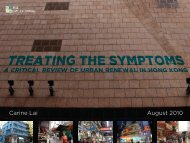Untitled - Civic Exchange
Untitled - Civic Exchange
Untitled - Civic Exchange
Create successful ePaper yourself
Turn your PDF publications into a flip-book with our unique Google optimized e-Paper software.
Chapter 4:<br />
Strategies for Minimizing Vehicle Trips - Promoting Pedestrianism in Hong Kong<br />
Relatively little has been done to improve pedestrian walkways and other on-street pedestrian facilities,<br />
like plazas, to create a friendly pedestrian environment and to better connect pedestrian zones.<br />
Institutional obstacles<br />
Current institutional arrangements present yet another obstacle to long-term, comprehensive pedestrian<br />
planning in Hong Kong. Numerous government departments are involved in the planning and provision of<br />
pedestrian facilities. 114 For example, the Transport Department is responsible for traffic management issues<br />
at the district level and hence responsible for the provision of pedestrian facilities in relation to pedestrian<br />
usage levels and vehicular traffic flow. The Highways Department (HyD), on the other hand, is responsible<br />
for the planning, design, construction, and maintenance of the public road system, including sidewalks. 115<br />
Regional Offices of the HyD also look after the maintenance of roads and street furniture. The Planning<br />
Department and the Town Planning Board prepare and approve layout plans and are concerned with the<br />
provision of basic pedestrian facilities, among other planning requirements. While it seems that the<br />
Transport Department has final responsibility for coordinating pedestrian planning, it does not adequately<br />
oversee the planning, design, implementation, and management of pedestrian facilities. The diffusion of<br />
planning and policy-making across government agencies impedes implementation of comprehensive<br />
pedestrian plans. See Chapter 7 for a more detailed discussion of this issue.<br />
Similar coordination problems also exist between the government and various stakeholders, such as the<br />
local community (residents and local businesses), private developers, and professionals. For example, at<br />
the local level, District Councils are consulted on new pedestrian schemes only after plans have been<br />
proposed. Thus, although they are often most aware of local needs, District Councilors are involved in<br />
implementation of government plans, rather than concept development or discussion of specific design<br />
features. Nor does the public have a voice. While it can be argued that the District Councils provide a<br />
channel for local ideas to reach the government, this method of obtaining local input on government<br />
projects is far too passive. Equally, much work remains to be done in fostering a strong public-private<br />
partnership to promote pedestrianism in Hong Kong. The involvement of private developers is crucial<br />
because the design of private development sites affects pedestrian movements and the ways in which<br />
pedestrian networks can be connected. At present, there are no regulations requiring developers to<br />
provide pedestrian facilities or walkways. 116<br />
4.4 Recommendations<br />
In order to promote pedestrianism in Hong Kong, it is necessary to develop a mission statement to direct<br />
policy across different agencies. We recommend that the central objective for pedestrian planning in Hong<br />
Kong be to provide pedestrians with a quality environment for walking to meet mobility and other needs.<br />
This mission statement would allow pedestrian spaces to become an integral part of a livable and<br />
sustainable community. It would provide safe, convenient, and "green" corridors for pedestrian movement.<br />
It would also provide a street space that belongs to the people and is a focal point for social and cultural<br />
interaction.<br />
In terms of transport, pedestrian planning should aim to promote walking as a transport mode, so as to<br />
encourage a shift from motorized trips to walking trips for short distances and to further promote the use<br />
of public transport, as this will make associated journeys by foot safer and more pleasant. In the long-term,<br />
114 Citizens Party (1999), A Walk on the Wild Side: Better Planning for Pedestrians in Hong Kong, Hong Kong,<br />
p.2.<br />
115 Highways Department at , section on departmental overview.<br />
116<br />
Brown, F. (2001), "Pedestrians: the need for a new approach," p.197.<br />
37

















